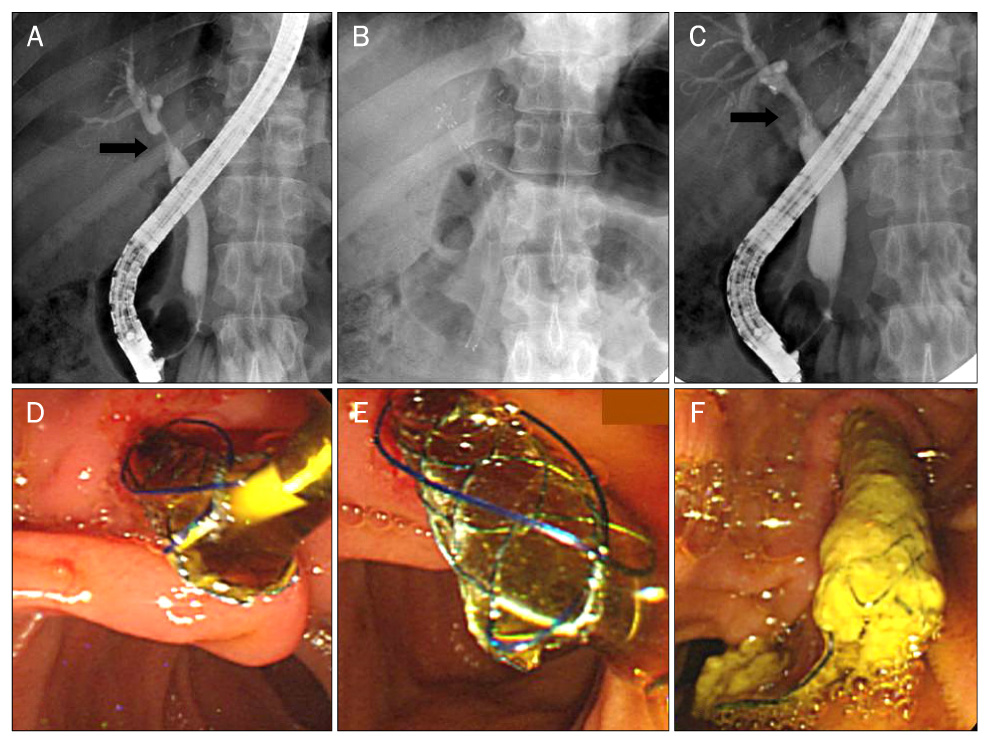Korean J Gastroenterol.
2012 Jan;59(1):58-60. 10.4166/kjg.2012.59.1.58.
Fully Covered Self Expandable Metal Stent for the Treatment of Benign Biliary Strictures
- Affiliations
-
- 1Department of Internal Medicine, Samsung Medical Center, Sungkyunkwan University School of Medicine, Seoul, Korea. happymap@skku.edu
- KMID: 1775835
- DOI: http://doi.org/10.4166/kjg.2012.59.1.58
Abstract
- No abstract available.
MeSH Terms
Figure
Reference
-
1. van Boeckel PG, Vleggaar FP, Siersema PD. Plastic or metal stents for benign extrahepatic biliary strictures: a systematic review. BMC Gastroenterol. 2009. 9:96.2. Pozsár J, Sahin P, László F, Topa L. Endoscopic treatment of sphincterotomy-associated distal common bile duct strictures by using sequential insertion of multiple plastic stents. Gastrointest Endosc. 2005. 62:85–91.3. Costamagna G, Pandolfi M, Mutignani M, Spada C, Perri V. Long-term results of endoscopic management of postoperative bile duct strictures with increasing numbers of stents. Gastrointest Endosc. 2001. 54:162–168.4. Shin HP, Kim MH, Jung SW, et al. Endoscopic removal of biliary self-expandable metallic stents: a prospective study. Endoscopy. 2006. 38:1250–1255.5. van Berkel AM, Cahen DL, van Westerloo DJ, Rauws EA, Huibregtse K, Bruno MJ. Self-expanding metal stents in benign biliary strictures due to chronic pancreatitis. Endoscopy. 2004. 36:381–384.6. Cantù P, Hookey LC, Morales A, Le Moine O, Devière J. The treatment of patients with symptomatic common bile duct stenosis secondary to chronic pancreatitis using partially covered metal stents: a pilot study. Endoscopy. 2005. 37:735–739.7. Baron TH. Covered self-expandable metal stents for benign biliary tract diseases. Curr Opin Gastroenterol. 2011. 27:262–267.8. Park JK, Moon JH, Choi HJ, et al. Anchoring of a fully covered self-expandable metal stent with a 5F double-pigtail plastic stent to prevent migration in the management of benign biliary strictures. Am J Gastroenterol. 2011. 106:1761–1765.9. Kim BU, Goo JC, Cho YS, et al. The efficacy and safety of fully covered self-expandable metal stents in benign extrahepatic eiliary strictures. Korean J Gastrointest Endosc. 2011. 42:11–19.10. Lee SS, Lee KT, Lee SY, et al. Biliary complications after adult liver transplantation. Korean J Gastrointest Endosc. 2006. 32:94–100.
- Full Text Links
- Actions
-
Cited
- CITED
-
- Close
- Share
- Similar articles
-
- Role of Fully Covered Self-Expandable Metal Stent for Treatment of Benign Biliary Strictures and Bile Leaks
- Refractory benign biliary stricture due to chronic pancreatitis in two patients treated using endoscopic ultrasound-guided choledochoduodenostomy fistula creation: case reports
- The Efficacy and Safety of Fully Covered Self-expandable Metal Stents in Benign Extrahepatic Biliary Strictures
- Current Status of Biliary Metal Stents
- Management of Benign and Malignant Pancreatic Duct Strictures



